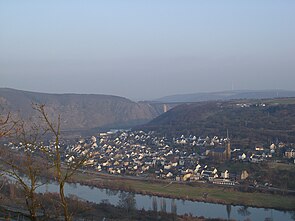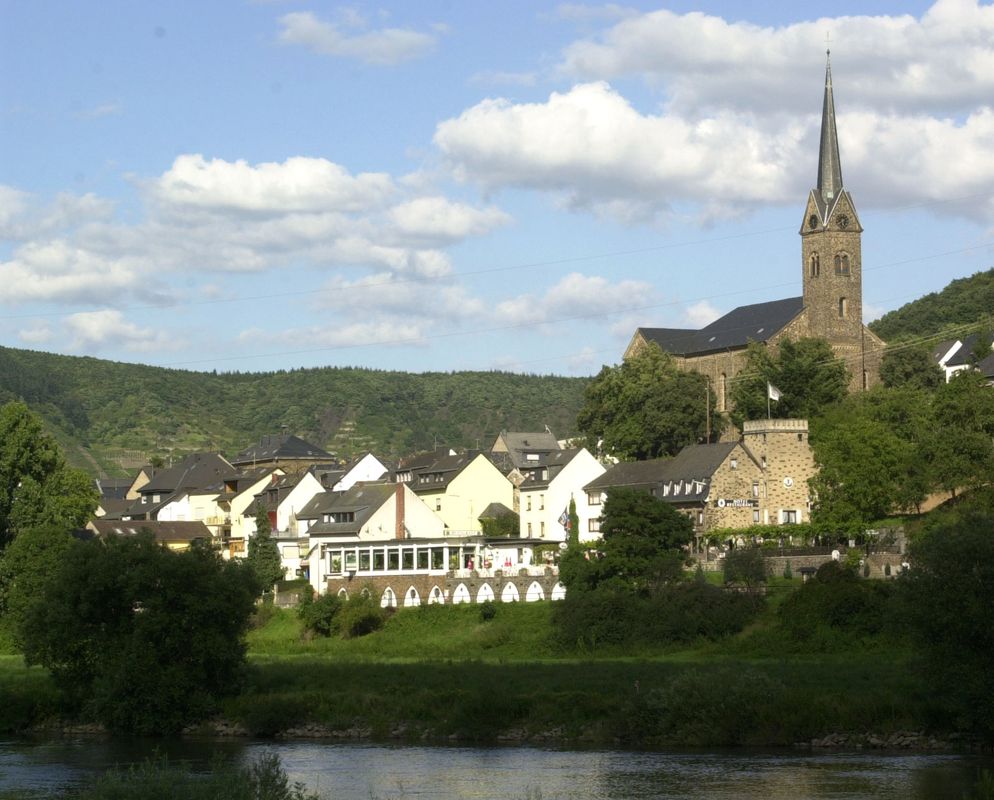Dieblich
Dieblich is a municipality and a wine and Obstanbauort on the so-called Terrassenmosel in Rhineland-Palatinate district of Mayen -Koblenz. It belongs to the municipality Untermosel, which has its administrative headquarters in Kobern -Gondorf. Dieblich is a nationally recognized tourist.
- 3.1 municipal
- 3.2 Coat of Arms
- 3.3 community partnerships
- 4.1 Structures
- 5.1 vineyards and orchards
- 5.2 traffic
- 5.3 Formation
- 6.1 Nature
- 6.2 transmitter of the SWR
Geography
Geographical location
Dieblich lies on the right bank of the Moselle about 15 kilometers from Koblenz and 35 kilometers from Cochem in the slip of the Dieblicher Mosel arch. Neighboring towns are upriver Low Fell and down the Moselle Lay, a district of Koblenz. On the other side of the Moselle is Kobern -Gondorf. At the hamlet of Maria Roth borders the community forest Esch.
Expansion of the municipal area
The district Dieblich stretches over a length of about 2 kilometers on the Mosel shore. Above on the meanders of the Moselle mountain lies the district Dieblich Mountain. The municipality also includes the villages of Maria Roth and Naßheck, which geographically are already in the Hunsrück, as well as residential places PROTEC, depots, Kondertal, Kührerhof, Lohbuschhof, silver Berghof, Talwel, Heidehof.
Climate
Like other communities of the Lower Moselle is Dieblich climatically favored in one of the warmest regions in Germany.
History
Dieblich Divelich was first mentioned in a document of Trier Archbishop Theodoric II on April 20, 1231 under the name.
The development of the population of Dieblich, the values from 1871 to 1987 based on population censuses:
Policy
Parish council
The local council in Dieblich consists of 16 council members, who were elected at the municipal election held on 7 June 2009 of personalized proportional representation, and the honorary mayor as chairman.
The distribution of seats in the local council:
Coat of arms
The blazon is: "Divided by silver and red, above a continuous ( ground ) red cross bar, down a silver heraldic rose without sepals with gold slugs, a petal pointing downward ."
Coat of arms meaning: The red cross indicates the affiliation of the place on Kurtrier out (until the end of the 18th century ), the white rose on the knight dynasty of Dieblich, called by Mielen that led a red rose in silver (14th century).
Unofficial district coat of arms:
Community partnerships
Dieblich has partnerships with the French place Marzy in Burgundy and with the Belgian army place in the Flanders region.
Culture and sights
Structures
- Located in the city is the Johann Claudius, built in 1829 by Lassaulx old school. There, now houses the municipal administration.
- The Catholic parish church of St. John was built 1844-1848 by Ferdinand fog.
- Near the church there is an old castle house with flashy hip roof with dormer double row - the Heesen castle. It comes from the 13th century and belonged to the family of the Koblenz Arken. 1514 sold Marsilius of Arken the property to the family Muhl of elms. Baron Johann Philipp Ernst and from the Hees inherited the castle 1762nd The east side is wearing a single-storey timber-framed building with Zwerchgiebelabschluss, the southwest corner of a re-erected in modern times of the four original bay window as octagonal truss bay.
- Another former castle, which Zanter or Zander castle got its name also from one of their last owner who Zandt Family of Merl. Originally from the long-established aristocratic family hare of Dieblich in 13-14. Erected century, came the noble house 1479 after the extinction of the family with Eberhard hare of Dieblich at Ruprecht of Reil, and later at the Koblenz bailiff Dietrich von Dietz. Then followed up to 1679, the family Zandt of Merl, which became extinct with IH Zandt of Merl. Later inherited from him the Barons of the High Feldt the estate. After that, the building served for a longer period as a rectory.
Economy and infrastructure
Vineyards and orchards
Dieblich is a wine and fruit growing community. The site belongs to the " wine field Cochem " in the Mosel region. In the town three wineries operate, the area under vines is 2 ha Approximately 80 % of the cultivated wine are white wine varietals (as of 2010 ).
The only Dieblicher vineyard ( Dieblicher healing trench ) located upriver of the town in the direction of low fur. Mosel and down on the mountain Dieblicher are apple, sweet cherry and plum orchards. On the mountain Dieblicher also vegetables are grown (including asparagus and pumpkins ) and cereals.
Traffic
On the banks of the Moselle along the B 49 leads through the village. About the B 411 is connected to the A 61 The connection point Dieblich is located in the immediate vicinity of Moseltalbrücke, on the A61 spans the River Moselle in about 136 meters.
A regular bus service is in the direction of Koblenz and castles.
The ferry to Kobern -Gondorf was discontinued in the 1970s. Since 1977 there is a bridge connection between Kobern- Gon and Low Fell.
Education
- In the district Dieblich is a primary school.
- Dieblich has its own kindergarten.
Others
Nature
On the banks of the Mosel in Dieblich you can still find the extremely rare dice snake that lives in the water. The Moselle was provided for this reason a few years ago under protection. The nature reserve extends from the former ferry pier Dieblich to the Moselle Gold Bridge, connecting the low fur with Kobern -Gondorf. The area of the ferry terminal was renatured. Erected on the B 49 and on the Moselle foreland information panels about the nature reserve.
Transmitter of the SWR
Near Dieblich the Southwest Broadcasting operates a transmitter for FM and TV, the station Koblenz ( Dieblich - Naßheck ). As antenna support a 280 meter high guyed lattice steel mast used.
Pictures
Parish Church
Aerial view 2007










